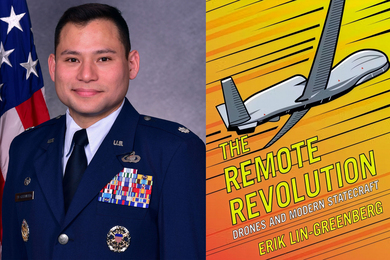Otto Piene, the internationally respected sculptor known for his stunning and majestic sky figures-rainbows at the Olympics and along the Charles River, starbursts over Berlin on its 750th anniversary, colorful flowers gracing the Washington sky at 350 feet-has retired as director of the MIT Center for Advanced Visual Studies (CAVS).
In his nearly 20 years in that post, Professor Piene has been the leading figure in the effort to create a new level of experiencing art by bringing technology into the creative process. He has been a leading force in demonstrating the interdependency of art, nature and science, and in emphasizing the civic and public role of art.
A recent review of an MIT exhibit of some of his work said, "Piene celebrates not only the wonder of flight (with his inflatable sculptures) but the beauty of the open sky he uses as his canvas. Weather adds a sense of risk; a healthy respect for the power of nature underlies each work. His events have all been exuberantly interactive; in placing the sculptures' moorings in the hands of volunteers, Piene makes his helpers into both artists and pilots. Consequently, the art that happens is as much about group spirit and the vagaries of the wind as it about nylon sculptures."
The exhibit in the Compton Gallery includes "notebook pages cluttered with scribbles and diagrams and miniature models for some of Piene's projects (which) demonstrate why this artist has thrived at a place like MIT." (A review, by Cate McQuaid of The Boston Phoenix is reprinted on Page XXX).
Professor Piene's retirement, effective September 1, was announced by Dean William J. Mitchell of the School of Architecture and Planning and by Associate Provost for the Arts Ellen T. Harris. Professor Piene has been named Professor Emeritus.
They also announced that a search will be undertaken to find "an artist with international standing and a strong record of artistic production and critical acclaim to fill Professor Piene's faculty position. They noted, "The exploration of the connections between art and technology has become a strong MIT tradition and it will continue. It is now time to seek new ways to invigorate this exciting intellectual work."
Professor Piene, who has established MIT as an important locus internationally for furthering the union of art and technology, will play a key role in this planning effort, Dean Mitchell and Provost Harris said, as the chair of an MIT Advisory Council on Art and Technology, which he will organize.
"The group Professor Piene will assemble will advise us not only on general intellectual direction, but also on such pressing practical matters as finding a suitable home for works created by CAVS members," Dean Mitchell and Provost Harris said. The CAVS will continue to be a part of the School of Architecture and Planning through the current academic year. Professor Piene will occupy a studio and office being built for him at N52, near the MIT Museum and MIT's Visual Arts Program.
The CAVS was established in 1967 and has been directed by Professor Piene since 1974. It has been an important hub for creative and scholarly work involving the relationship of the visual arts and technology.
In the spirit of the CAVS founding director, the painter and author Gyorgy Kepes, Professor Piene fostered a creative collaboration of artists, scientists and engineers at the center. He was successful in increasing the involvement of other sectors of MIT with the CAVS. For example, his Light Satellite sculpture and the 1,600-foot Rainbow, both for the 1972 Munich Olympic Games, were carried out in collaboration with the late Professor Harold Edgerton of the Department of Electrical Engineering and Computer Science (the developer of the strobe light) and Professor Walter H.G. Lewin of the Department of Physics, an authority on balloon-born X-ray astronomy who has a deep interest in modern art.
The 25th anniversary of CAVS will continue to be celebrated into the spring of 1994, when a major retrospective exhibition of the work of CAVS artists will open at the MIT Museum. A book documenting the work of the Center is being prepared to coincide with the exhibition.
Professor Piene was born in Germany in 1928 and studied art, art history and art education at the Blocherer-Schule of Fine Arts in Munich, the Munich Academy of Fine Arts and the Dusseldorf Academy of Fine Arts. He studied philosophy at Cologne University.
In 1957 he cofounded with Heinz Mack Group Zero, an international assembly of artists interested in kinetic, environmental and elementary art, and went on to publish Zero magazines and to organize and design exhibitions and the first sky events under the Zero aegis.
His first one-man show in Dusseldorf in 1959 included his Archaic Light Ballet and served as a formal announcement of his concern with involving spectators in a response to the elements. He later wrote: "By elements, I do not only mean the classic Greek elements: fire, water, air and earth. I also mean the human elements of action, reaction, involvement, participation."
Numerous one-man shows followed in Europe and the US and he participated in countless group exhibitions around the world. His work is represented in more than 100 museums.
Professor Piene continues to be active on the international art scene. He is currently working on a major architectural commission in Dusseldorf for the glass dome of a building that is part of the city's current cultural development project. In addition, a book on Professor Piene and his work will be published by the Paris Art Center in fall of 1994.
The exhibit at the Compton, "Otto Piene: Sky Art," opened April 16 and closes September 10. It presents documentation of a variety of Sky Art events, including photographs and notebook sketches.
A version of this article appeared in the September 8, 1993 issue of MIT Tech Talk (Volume 38, Number 5).





